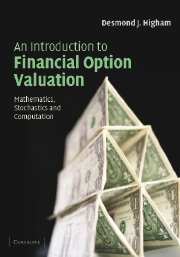Book contents
- Frontmatter
- Contents
- List of illustrations
- Preface
- 1 Option
- 2 Option valuation preliminaries
- 3 Random variables
- 4 Computer simulation
- 5 Asset price movement
- 6 Asset price model: Part I
- 7 Asset price model: Part II
- 8 Black–Scholes PDE and formulas
- 9 More on hedging
- 10 The Greeks
- 11 More on the Black–Scholes formulas
- 12 Risk neutrality
- 13 Solving a nonlinear equation
- 14 Implied volatility
- 15 Monte Carlo method
- 16 Binomial method
- 17 Cash-or-nothing options
- 18 American options
- 19 Exotic options
- 20 Historical volatility
- 21 Monte Carlo Part II: variance reduction by antithetic variates
- 22 Monte Carlo Part III: variance reduction by control variates
- 23 Finite difference methods
- 24 Finite difference methods for the Black–Scholes PDE
- References
- Index
11 - More on the Black–Scholes formulas
Published online by Cambridge University Press: 05 June 2012
- Frontmatter
- Contents
- List of illustrations
- Preface
- 1 Option
- 2 Option valuation preliminaries
- 3 Random variables
- 4 Computer simulation
- 5 Asset price movement
- 6 Asset price model: Part I
- 7 Asset price model: Part II
- 8 Black–Scholes PDE and formulas
- 9 More on hedging
- 10 The Greeks
- 11 More on the Black–Scholes formulas
- 12 Risk neutrality
- 13 Solving a nonlinear equation
- 14 Implied volatility
- 15 Monte Carlo method
- 16 Binomial method
- 17 Cash-or-nothing options
- 18 American options
- 19 Exotic options
- 20 Historical volatility
- 21 Monte Carlo Part II: variance reduction by antithetic variates
- 22 Monte Carlo Part III: variance reduction by control variates
- 23 Finite difference methods
- 24 Finite difference methods for the Black–Scholes PDE
- References
- Index
Summary
OUTLINE
irrelevance of the asset growth rate
behaviour as time increases
Black–Scholes surfaces
re-scaling the formulas
Motivation
We now take the opportunity to reflect a little more on the Black–Scholes option valuation formulas. In particular, Figure 11.3 is an attempt to squeeze everything we have learnt into a single picture.
Where is µ?
The Black–Scholes formulas allow us to determine a fair price at time zero for a European call or put option in terms of the initial asset price, S0, the exercise price, E, the asset volatility, σ, the risk-free interest rate, r, and the expiry date, T. Each of these quantities is known, with the exception of the asset volatility, σ. Chapters 14 and 20 are concerned with the task of estimating σ using information available from the market. A big surprise, and perhaps the most remarkable aspect of the Black–Scholes theory, is that the option price does not depend on the drift parameter, µ, which, from (6.11), determines the expected growth of the asset. A consequence is that two investors could have wildly different views about what is an appropriate value of µ for a particular asset and yet, if they agreed on the volatility and accepted the assumptions that go into the Black–Scholes analysis, they would come up with the same value for the option.
Information
- Type
- Chapter
- Information
- An Introduction to Financial Option ValuationMathematics, Stochastics and Computation, pp. 105 - 114Publisher: Cambridge University PressPrint publication year: 2004
